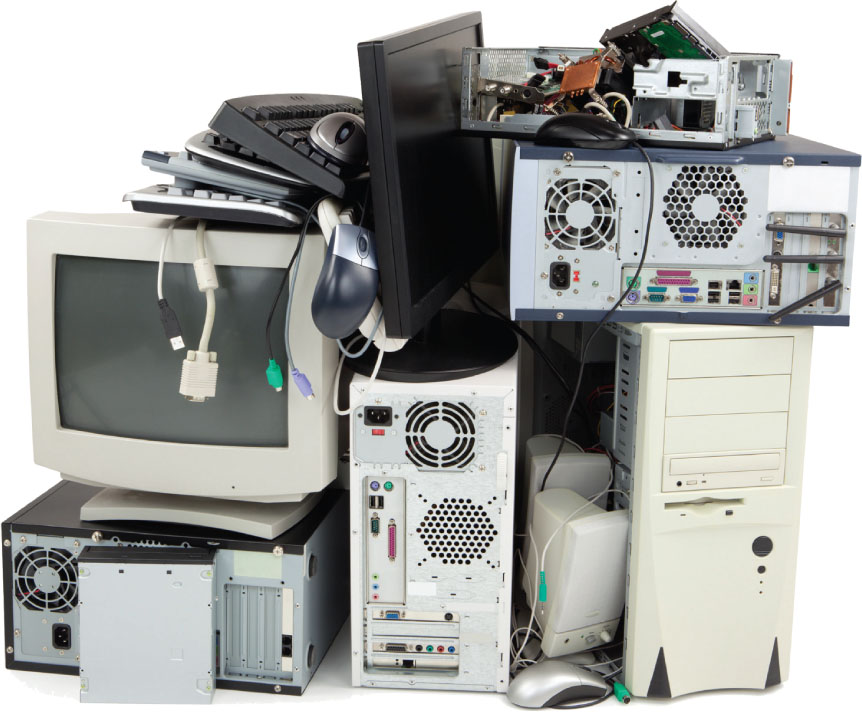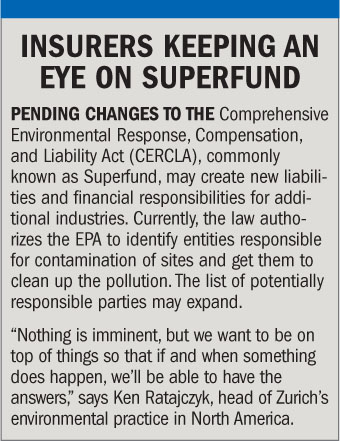To compete in a marketplace flooded with options,environmental-insurance carriers, to better stand out from thepack, are developing new products—built on a growing familiaritywith and sophisticated grasp of the unique coverage requirements ofspecific industry classes.
| “There has been innovation towardcertain [industry] groups as our understanding of clients and theirspecialized needs grows,” says Rich Corbett, president ofenvironmental operations in North America for XL Insurance.
“There has been innovation towardcertain [industry] groups as our understanding of clients and theirspecialized needs grows,” says Rich Corbett, president ofenvironmental operations in North America for XL Insurance.
Chartis, for example, has launched a relatively new suite ofenvironmental-insurance solutions, called NextGen Protection. Eachof the products is designed explicitly for select industries suchas healthcare, municipalities, commercial real estate and wastemanagement.
|“This approach is a lot easier for insureds,” says Lana Keppel,executive vice president of corporate accounts for Chartis. “We'vemanuscripted the policy for them. Endorsements do not need to benegotiated.”
|In order to develop this new line of products, Chartis, whichhas an in-house engineering department, intensively studied all ofthe losses it has seen in each industry to better grasp theassociated risks, Keppel says.
|The new product offerings have gained traction with “a lot ofbrokers we haven't done business with in the past,” she says. “It'sa nice way to broaden their book of business.”
|Chartis has plans to release many more industry-specificproducts based on the degree of need in the marketplace.
|“We get our best ideas from agents and brokers,” Keppeladds.
|Zurich Financial Services also has an approach targeted toindustry sectors and is currently on a road show to meet withbrokers to discuss current issues and trends in environmentalinsurance and other coverage classes in order to learn how Zurichcan step in and mitigate risks.
|Ken Ratajczyk, head of Zurich's environmental practice in NorthAmerica, says in one recent move the company has aligned itsenvironmental and construction units to better servecontractors.
|In the past, the amount of environmental work a contractor diddetermined whether the business was insured by the environmental orconstruction division. Now, the process is streamlined by lining upthe divisions, Ratajczyk says.
|EMERGING OPPORTUNITiES
|Opportunities in the ever-evolving environmental-insurancemarket are always emerging, says Mary Ann Susavidge, chiefunderwriting officer for environmental at XL.
|Some opportunities may arise from a better understanding of riskonce deemed untouchable.
|“No one wanted to touch mold 10 years ago,” she notes as anexample of a now-common coverage once deemed too risky.
|Earlier this year XL unveiled a product developed exclusivelyfor technology-waste recyclers. As electronics are discarded, thesemillions of units of computers, cell phones, monitors, etc.—whichcan contain lead, mercury, cadmium and other pollutants—are causinggrowing concern.
|Worry over the risks embedded in these e-objects is strongenough that 24 states have enacted legislation banning these itemsfrom the waste system.
|Therefore, an industry of recyclers has been formed—and theyhave very specific insurance needs.
|“These types of businesses need to be prepared to handle notonly the toxic chemicals—but also the private information containedwithin the electronics,” says Corbett.
|So XL's one-of-a-kind insurance solution protects the businessand gives the customer assurances that the data will be destroyedproperly, the carrier says.
|“The unique needs of these recyclers would not be addressed [ina standard environmental policy],” Corbett explains.
|Another burgeoning business opportunity: Mergers andacquisitions activity, which generates many placements ofenvironmental-liability contracts, is heating up again, or atleast, “showing signs of a bounce back,” Keppel says—with XL'sSusavidge agreeing that M&A has picked up in the first half ofthis year.
|Corbett and Susavidge both point to hydro-fracturing as anemerging risk. The controversial process is used to get tonatural-gas sources. (See a full story on the insuranceopportunities and challenges associated with “fracking” on page26.)
|Though no one wishes for disasters, they can create opportunity.Remediation contractors hired to clean up and fix messes left bynatural (like the recent tornadoes) or man-made catastrophes oftenneed environmental coverage to get the job, says David Brereton,environmental-impairment liability (EIL) program manager forFreberg Environmental Insurance (FEI).
|CROWDED FIELD; WHITHER PRICING?
|For the past few years, many in the industry saw environmentalcoverage as The Next Big Thing. As a result, carriers flooded intothe space.
|And now, Zurich's Ratajczyk says 2011 “probably has the mostamount of carriers providing environmental insurance” than at anytime since this line of insurance was created in the early 1980s aslegislation regarding clean water and air wasadopted.
| Despite all these playerscompeting for business, prices are stabilizing, says Brereton ofFEI, a managing general agent that writes coverage throughEndurance Specialty Holdings' U.S. operations. “There has been anuptick in pricing with certain carriers,” he says.
Despite all these playerscompeting for business, prices are stabilizing, says Brereton ofFEI, a managing general agent that writes coverage throughEndurance Specialty Holdings' U.S. operations. “There has been anuptick in pricing with certain carriers,” he says.
XL's Corbett says the soft market persists, although “spottyareas are more flat, based on the loss histories of individualclients.”
|Competition could increase when a group of multi-year insurancecontracts expire, observes Ratajczyk.
|OneBeacon Insurance Group has recently entered the market and isseeing business from insureds that have not purchased environmentalcoverage before, says Devin Claypool, vice president of OneBeaconEnvironmental.
|Claypool believes that “there are still a lot of accounts outthere” to be had. Many companies are currently shopping. “There's alot of movement,” he adds.
|CONSTRUCTION & CONTRACTUAL REQUIREMENTS
|Most of the current action is coming from contractualrequirements to carry environmental coverage in construction orpublic-entity projects (road or sewer), Claypoolsays.
|Chartis's Keppel also expects a lot of environmental business toarise from the construction sector—once projects still “sitting inthe bid process” start to move forward.
|“A lot of those [construction] contracts are pending right nowwhile they wait to get funded,” Keppel adds.
|The good news for insurance providers is that lenders today arerequiring borrowers involved in construction or development dealsto have environmental insurance, whereas “five years ago they wereso competitive, the banks wouldn't think of asking,” she says.
|This fact may come into play when commercial real estate loansare refinanced, says Ratajczyk, whose Zurich offers coverage forfinancial institutions involved in financing risky constructionprojects, to protect them against default and pollutionconditions.
|Contractors must also be prepared to deal with risks associatedwith Environmental Protection Agency standards dealing with leadpaint in older buildings and homes, Brereton adds.
|MORE ADVANCED & AFFORDABLE—BUT STILLDISCRETIONARY
|Overall interest in environmental insurance is “definitelygrowing,” says Keppel, with products becoming more advanced andaffordable.
|Companies are looking more closely at their environmentalliability, and insurers are working on education in the brokeragecommunity, adds Susavidge.
|However, the purchase remains mainly discretionary. Customersare sometimes “hesitant to spend the money on optional insurance,”says Susavidge. “Economic conditions are still prettychilling.”
|Adds Ratajczyk: “Everyone has some environmental risk; it's amatter of determining how big you perceive yours to be. But everyoperation at some level generates some waste.”
Want to continue reading?
Become a Free PropertyCasualty360 Digital Reader
Your access to unlimited PropertyCasualty360 content isn’t changing.
Once you are an ALM digital member, you’ll receive:
- All PropertyCasualty360.com news coverage, best practices, and in-depth analysis.
- Educational webcasts, resources from industry leaders, and informative newsletters.
- Other award-winning websites including BenefitsPRO.com and ThinkAdvisor.com.
Already have an account? Sign In
© 2024 ALM Global, LLC, All Rights Reserved. Request academic re-use from www.copyright.com. All other uses, submit a request to [email protected]. For more information visit Asset & Logo Licensing.








